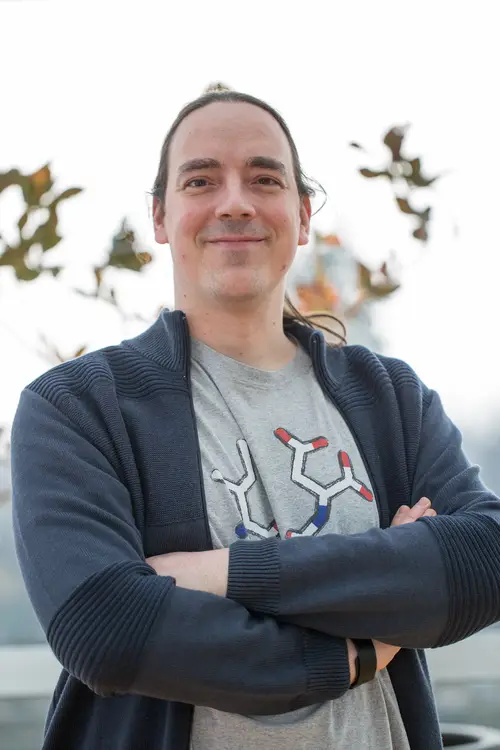Ajasja Ljubetič

: Damjan Makuc
The vision for my research group is to design and study mechanic protein assemblies capable of producing work and make the first steps towards designer nanorobots.
CV INFO
- EDUCATION AND KEY QUALIFICATIONS
- 2015-03 PhD, “ Solving Membrane Protein Structures Using Measured and Modelled Side-Chain Conformational Spaces ”, Biomedicine, University of Ljubljana, Slovenia Mentor: Prof. Janez Štrancar
- 2009 Bachelors, FKKT/Biochemistry, University of Ljubljana, Slovenia
- CURRENT POSITION(S)
- 2018 – Research Assistant Professor, Department for synthetic biology and immunology, National Institute of Chemistry, Ljubljana, Slovenia
- PREVIOUS POSITIONS
- 2021 – 2022 Marie-Skłodowska-Curie Fellow (integration phase, in Slovenia)
- 2020 – 2021 Visiting Academic, Baker Lab, Institute for protein design, University of Washington, Seattle, USA. Mentor: Prof. David Baker
- 2018 – 2020 Senior Fellow, Baker Lab, Institute for protein design, University of Washington, Seattle, USA. Mentor: Prof. David Baker
- 2018 – 2020 Marie-Skłodowska-Curie Fellow (outgoing phase)
- 2015 – 2018 Postdoctoral Research Associate, Department for synthetic biology and immunology, National Institute of Chemistry, Ljubljana, Slovenia. Mentor: Prof. Roman Jerala
- 2009 – 2015 Young researcher, F5-Condensed Matter Physics, Institute “Jozef Stefan”, Ljubljana, Slovenia. Mentor: Prof. Janez Štrancar
I have made contributions in three main research fields.
Biophysics and microscopy: During my PhD I developed a method to obtain position specific diffusion coefficients from MD simulations that was used in structure determination of membrane peptides. I have also gained a strong interest in fluorescent microscopy. Later I specialized in fluorescence correlation spectroscopy and in single molecule microscopy.
Design of novel coiled coil structures: I designed a platform (CoCoPod) that enables design of arbitrary polyhedra, limited only by the number of orthogonal CCs. I have also extended the affinity and number of CC building blocks.
De novo protein design: I successfully won an MSCA fellowship that enabled me to work in the lab of David Baker at UW. I designed four helix bundles with buried hydrogen bond networks to use as feet for the random protein walker. I also contributed to COVID research and to the Rosetta modelling suite.
I also have experience with Cryo-EM and my students regularly use the in-house Cryo-EM microscope.
Publications
(see all on Google Scholar).
2025
Liza Ulčakar, Hao Shen, Eva Rajh, Tadej Satler, Federico Alberto Olivieri, Joseph Watson, Yang Hsia, Justin Decarreau, Eric Michael Lynch, Justin Kollman, David Baker, Ajasja Ljubetič✉
BioArxiv, October 2025 (Read more)
2024
A Baryshev*, A La Fleur*, B Groves, C Michel, D Baker, A Ljubetič✉, G Seelig✉
Nature chemical biology, August 2024 (Read more)
T Plaper, E Merljak, T Fink, T Satler, A Ljubetič, D Lainšček, V Jazbec, M Benčina, S Stevanoska, S Džeroski, R Jerala
Cell Discovery, January 2024 (Read more)
2023
WC Boldridge*, A Ljubetič*✉, H Kim, N Lubock, D Szilágyi, J Lee, A Brodnik, J Jerala✉, S Kosuri✉
Nature Communications, August 2023 (Read more)
2022
Dhwanit Dave, Tlalit Massarano, Itai Katzir, Žiga Strmšek, Ajasja Ljubetič, Deborah Sementa
Chem, February 2022 (Read more)
J Linder, A La Fleur, Z Chen, A Ljubetič, D Baker, S Kannan, G Seelig
Nature machine intelligence, January 2022 (Read more)
2017
A Ljubetič*, F Lapenta*, H Gradišar, I Drobnak, J Aupič, Ž Strmšek, D Lainšček, I Hafner-Bratkovič, A Majerle, N Krivec, M Benčina, T Pisanski, TĆ Veličković, A Round, JM Carazo, R Melero, R Jerala
Nature biotechnology, October 2017 (Read more)
A Ljubetič, H Gradišar, R Jerala
Current opinion in chemical biology, October 2017